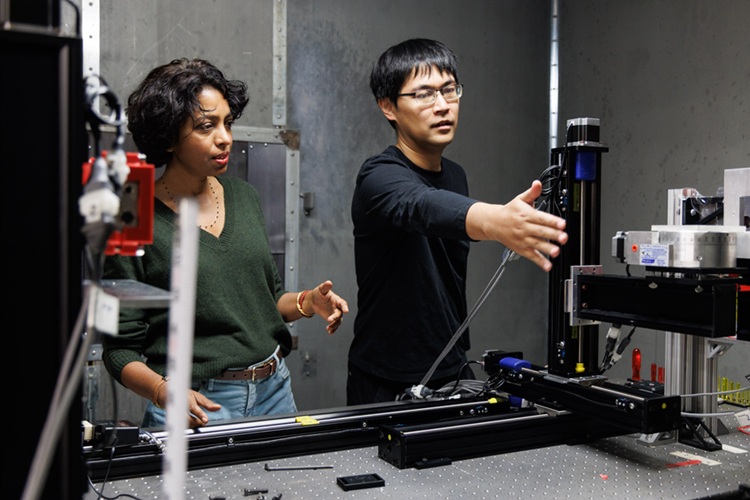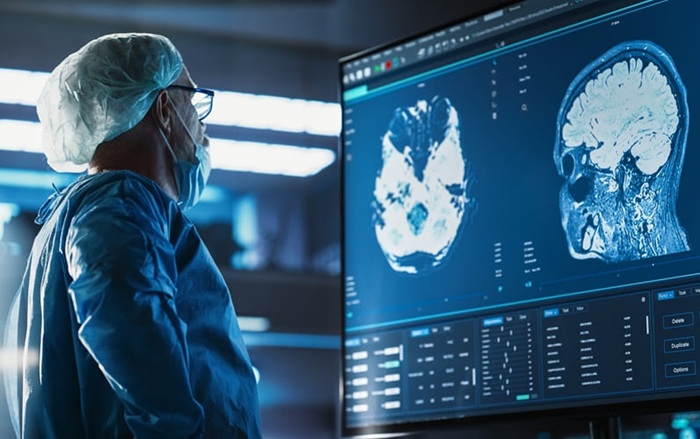New PET/MRI Probe Enables Early Detection of Difficult-to-Detect Diseases
|
By MedImaging International staff writers Posted on 06 Aug 2024 |
![Image: Current PET/MRI imaging of healthy and damaged mouse kidneys using the dual contrast agent [18F][Gd(FL1)] (Photo courtesy of IOCB Prague) Image: Current PET/MRI imaging of healthy and damaged mouse kidneys using the dual contrast agent [18F][Gd(FL1)] (Photo courtesy of IOCB Prague)](https://globetechcdn.com/mobile_medicalimaging/images/stories/articles/article_images/2024-08-06/07335303929145c6da075f04f6222984507b1361.jpg)
Medicine has long searched for ways to enhance imaging techniques, aiming to integrate the advantages of magnetic resonance imaging (MRI) and positron emission tomography (PET). MRI excels in imaging internal organs and tissues rich in water content, while PET can detect minute quantities of substances, making it adept at identifying molecular markers in cancer cells. Merging these technologies posed a challenge due to the intense magnetic fields of MRI, which interfere with PET's electronic functions. However, this obstacle has been overcome with the emergence of hybrid PET/MRI machines in clinical settings. The next hurdle was creating a dual-purpose contrast agent suitable for both PET and MRI. Now, a new hybrid contrast agent has properties that make it the first serious candidate for a PET/MRI agent usable in a clinical setting.
A research team from IOCB Prague (Prague, Czech Republic), working in collaboration with the University of Tübingen (Tübingen, Germany), and the Faculty of Science, Charles University (Prague, Czech Republic) , has developed a pioneering contrast agent usable in both MRI and PET. The simple and effective approach published in Angewandte Chemie could greatly improve the diagnosis and treatment of conditions like kidney diseases and tumors. Earlier efforts to create PET/MRI probes often resulted in complex molecules with challenging synthesis and limited use. The team simplified this by developing a versatile molecule, easy to understand and use by radiologists, maintaining all beneficial properties of standard MRI contrast agents while also providing PET imaging capabilities.
The new solution is a molecule that cleverly combines gadolinium and radioactive fluorine-18, a staple in medical imaging easily accessible for use. Addressing the challenge of the vast difference in the amounts required for MRI and PET, the research team innovated by substituting nonradioactive fluorine atoms in the MRI contrast agent with radioactive fluorine-18. This process is both fast and efficient, allowing automated synthesis to produce sufficient agent for five patients in under 30 minutes. During testing in a mouse model, this agent unexpectedly revealed kidney issues in a seemingly healthy mouse. The diseased kidney displayed filtration patterns only detectable through the combined power of PET and MRI, highlighting the agent's ability to noninvasively monitor the biochemical behavior, distribution, and accumulation in real time, providing invaluable diagnostic insights.
“This method represents a pioneering step toward personalized diagnostics, showcasing the significant diagnostic potential of our hybrid molecule,” said Prof. André Ferreira Martins at the University of Tübingen. “This is a revolutionary discovery in the field of precise imaging. We are on a path that will eventually allow us to determine not only what disease a patient has but also the stage, type, and aggressiveness of the condition.”
Related Links:
IOCB Prague
University of Tübingen
Faculty of Science, Charles University
Latest MRI News
- Novel Imaging Approach to Improve Treatment for Spinal Cord Injuries
- AI-Assisted Model Enhances MRI Heart Scans
- AI Model Outperforms Doctors at Identifying Patients Most At-Risk of Cardiac Arrest
- New MRI Technique Reveals Hidden Heart Issues
- Shorter MRI Exam Effectively Detects Cancer in Dense Breasts
- MRI to Replace Painful Spinal Tap for Faster MS Diagnosis
- MRI Scans Can Identify Cardiovascular Disease Ten Years in Advance
- Simple Brain Scan Diagnoses Parkinson's Disease Years Before It Becomes Untreatable
- Cutting-Edge MRI Technology to Revolutionize Diagnosis of Common Heart Problem
- New MRI Technique Reveals True Heart Age to Prevent Attacks and Strokes
- AI Tool Predicts Relapse of Pediatric Brain Cancer from Brain MRI Scans
- AI Tool Tracks Effectiveness of Multiple Sclerosis Treatments Using Brain MRI Scans
- Ultra-Powerful MRI Scans Enable Life-Changing Surgery in Treatment-Resistant Epileptic Patients
- AI-Powered MRI Technology Improves Parkinson’s Diagnoses
- Biparametric MRI Combined with AI Enhances Detection of Clinically Significant Prostate Cancer
- First-Of-Its-Kind AI-Driven Brain Imaging Platform to Better Guide Stroke Treatment Options
Channels
Radiography
view channel
X-Ray Breakthrough Captures Three Image-Contrast Types in Single Shot
Detecting early-stage cancer or subtle changes deep inside tissues has long challenged conventional X-ray systems, which rely only on how structures absorb radiation. This limitation keeps many microstructural... Read more
AI Generates Future Knee X-Rays to Predict Osteoarthritis Progression Risk
Osteoarthritis, a degenerative joint disease affecting over 500 million people worldwide, is the leading cause of disability among older adults. Current diagnostic tools allow doctors to assess damage... Read moreUltrasound
view channel
Wearable Ultrasound Imaging System to Enable Real-Time Disease Monitoring
Chronic conditions such as hypertension and heart failure require close monitoring, yet today’s ultrasound imaging is largely confined to hospitals and short, episodic scans. This reactive model limits... Read more
Ultrasound Technique Visualizes Deep Blood Vessels in 3D Without Contrast Agents
Producing clear 3D images of deep blood vessels has long been difficult without relying on contrast agents, CT scans, or MRI. Standard ultrasound typically provides only 2D cross-sections, limiting clinicians’... Read moreNuclear Medicine
view channel
PET Imaging of Inflammation Predicts Recovery and Guides Therapy After Heart Attack
Acute myocardial infarction can trigger lasting heart damage, yet clinicians still lack reliable tools to identify which patients will regain function and which may develop heart failure.... Read more
Radiotheranostic Approach Detects, Kills and Reprograms Aggressive Cancers
Aggressive cancers such as osteosarcoma and glioblastoma often resist standard therapies, thrive in hostile tumor environments, and recur despite surgery, radiation, or chemotherapy. These tumors also... Read more
New Imaging Solution Improves Survival for Patients with Recurring Prostate Cancer
Detecting recurrent prostate cancer remains one of the most difficult challenges in oncology, as standard imaging methods such as bone scans and CT scans often fail to accurately locate small or early-stage tumors.... Read moreGeneral/Advanced Imaging
view channel
New Algorithm Dramatically Speeds Up Stroke Detection Scans
When patients arrive at emergency rooms with stroke symptoms, clinicians must rapidly determine whether the cause is a blood clot or a brain bleed, as treatment decisions depend on this distinction.... Read more
3D Scanning Approach Enables Ultra-Precise Brain Surgery
Precise navigation is critical in neurosurgery, yet even small alignment errors can affect outcomes when operating deep within the brain. A new 3D surface-scanning approach now provides a radiation-free... Read moreImaging IT
view channel
New Google Cloud Medical Imaging Suite Makes Imaging Healthcare Data More Accessible
Medical imaging is a critical tool used to diagnose patients, and there are billions of medical images scanned globally each year. Imaging data accounts for about 90% of all healthcare data1 and, until... Read more
Global AI in Medical Diagnostics Market to Be Driven by Demand for Image Recognition in Radiology
The global artificial intelligence (AI) in medical diagnostics market is expanding with early disease detection being one of its key applications and image recognition becoming a compelling consumer proposition... Read moreIndustry News
view channel
GE HealthCare and NVIDIA Collaboration to Reimagine Diagnostic Imaging
GE HealthCare (Chicago, IL, USA) has entered into a collaboration with NVIDIA (Santa Clara, CA, USA), expanding the existing relationship between the two companies to focus on pioneering innovation in... Read more
Patient-Specific 3D-Printed Phantoms Transform CT Imaging
New research has highlighted how anatomically precise, patient-specific 3D-printed phantoms are proving to be scalable, cost-effective, and efficient tools in the development of new CT scan algorithms... Read more
Siemens and Sectra Collaborate on Enhancing Radiology Workflows
Siemens Healthineers (Forchheim, Germany) and Sectra (Linköping, Sweden) have entered into a collaboration aimed at enhancing radiologists' diagnostic capabilities and, in turn, improving patient care... Read more




















